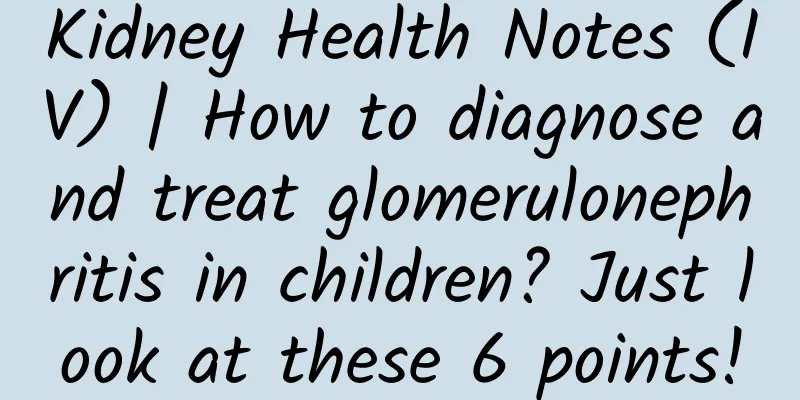Kidney Health Notes (IV) | How to diagnose and treat glomerulonephritis in children? Just look at these 6 points!

|
Glomerulonephritis (GN) is one of the common glomerular diseases in children, which often affects the health of children's kidneys. Reasonable diagnosis and clear treatment have a vital impact on the protection of children's kidney health. Therefore, this article summarizes 6 key points on the clinical diagnosis and treatment of GN in children for the learning and communication of clinical physicians. Point 1: Clarify the four characteristics of GN (1) GN refers to a spectrum of diseases in which glomeruli are damaged, and the characteristic changes are usually inflammatory changes in the glomerular capillary loops and glomerular basement membrane. (2) The injury may affect all or part of the glomerulus or glomerular capillary loops. (3) Inflammation is mostly immune-mediated. (4) Clinical manifestations include hematuria (including microscopic hematuria and macroscopic hematuria) and proteinuria (including microalbuminuria, non-nephrotic level proteinuria and nephrotic level proteinuria), with or without oliguria/edema, hypertension, abnormal renal function and extrarenal manifestations. Point 2: Clarify GN classification and staging (1) Etiology classification: According to the etiology, GN is divided into primary GN, secondary GN and hereditary GN. Primary GN includes IgA nephropathy, GN after streptococcal infection, GN after non-streptococcal infection, etc.; secondary GN includes lupus nephritis, purpuric nephritis, ANCA-associated vasculitis renal damage, hemolytic uremic syndrome, and secondary glomerular damage caused by inherited metabolic diseases such as methylmalonic aciduria combined with hyperhomocysteinemia, etc.; hereditary GN includes Alport syndrome. (2) Disease course staging: In the past, GN was divided into four stages: acute, progressive, protracted, and chronic GN, based on the clinical course and complications. At present, with the popularization of the concept of chronic kidney disease, GN is also clinically divided into two types: acute and chronic according to the course of the disease. That is, those with a course of less than 3 months are acute, and those with a course of ≥3 months are chronic. The course of disease classification no longer involves related complications such as renal function and hypertension. (3) Pathological classification: GN is a type of glomerular hypercellular disease characterized by proliferation of renal intrinsic cells and/or leukocyte infiltration. Based on the different etiologies/pathogenesis, combined with immunofluorescence/histochemistry, light microscopy and electron microscopy results, GN is divided into the following five categories: immune complex-mediated GN, ANCA-associated GN, anti-glomerular basement membrane GN, monoclonal Ig-mediated GN and C3 nephropathy. ① Immune complex-mediated GN is the most heterogeneous group of diseases, characterized by immunoglobulin deposition in renal pathological immunofluorescence, and the type and location of deposition are related to the cause, often accompanied by complement deposition, and light microscopic glomerular damage varies. Therefore, immunofluorescence and electron microscopy are needed to make a clear diagnosis. ②ANCA-related GN, immunofluorescence immunoglobulin or complement are mostly negative, immunoglobulin and C3 segment deposition are occasionally seen, and light microscopy is mostly necrotic or crescent GN, with various volumes and periods of change. Therefore, cellular, cellular fibrous and fibrous crescents can all be seen. ③ Anti-glomerular basement membrane GN, characterized by the presence of anti-glomerular basement membrane antibodies in the serum, immunofluorescence IgG linear deposition along the glomerular basement membrane, necrosis can be seen at the interruption, often accompanied by C3 segment deposition, light microscopy shows progressive crescents or necrotizing GN, and renal puncture in the early stage of the disease often shows large cellular crescents in the same period. About 25% of patients may also be accompanied by ANCA positivity. Key point 3: Clarify the stage of renal function GN is often accompanied by abnormal renal function. Currently, pediatric and adult clinical practice tends to use acute kidney injury and chronic kidney disease instead of abnormal renal function. The Kidney Disease Improving Global Outcomes Organization divides acute kidney injury into three stages based on serum creatinine levels: stage 1 is a serum creatinine increase of ≥26.5 μmol/L or 1.5-1.9 times; stage 2 is a serum creatinine increase of 2.0-2.9 times; stage 3 is a serum creatinine increase of more than 3.0 times, or a serum creatinine increase of ≥353.6 μmol/L, or the need to start renal replacement therapy, or the patient is <18 years old and the estimated glomerular filtration rate is <35 ml/(min·1.73m2). Chronic kidney disease is divided into five stages according to the glomerular filtration rate (GFR), as shown in Figure 1. Figure 1 Stratification basis Key point 4: Identify typical clinical manifestations In the acute phase, symptoms often include general discomfort, fatigue, lack of appetite, fever, headache, dizziness, cough, shortness of breath, nausea, vomiting, abdominal pain and nosebleed. (1) Edema: 70% of patients have edema, which usually only affects the eyelids and face. In severe cases, it can spread throughout the body within 2 to 3 days and is non-pitting. (2) Hematuria: 50% to 70% of cases have macroscopic hematuria, which usually turns into microscopic hematuria after 1 to 2 weeks. (3) Proteinuria: The degree varies. 20% of cases can reach nephrotic levels. Pathologically, patients with proteinuria often present with severe mesangial hyperplasia. (4) Hypertension: 30% to 80% of cases have elevated blood pressure. (5) Decreased urine volume: Severe cases of macroscopic hematuria may be accompanied by decreased urine volume. In addition, a small number of children may experience symptoms such as severe circulatory congestion, hypertensive encephalopathy and acute renal insufficiency in the early stages of the disease, which requires clinical diagnosis and accurate judgment based on the actual situation of the children. Point 5: Complete diagnosis in 6 steps The diagnosis of GN should follow the following procedures: (1) Symptom diagnosis, whether the clinical diagnosis is consistent with GN (hematuria and proteinuria are necessary conditions). (2) Course diagnosis, to determine whether the course is acute or chronic. It should be noted that if the cause is considered a hereditary disease, it should be diagnosed as chronic even if the time of discovery is less than 3 months. (3) Etiology diagnosis, to determine whether it is primary, secondary or hereditary GN. (4) Primary disease name diagnosis. (5) Pathological diagnosis. (6) Renal function diagnosis. Point 6: Take multiple measures and treat together (1) Pay attention to rest: In the acute phase, patients need to stay in bed for 2 to 3 weeks until the visible hematuria disappears, the edema subsides, and the blood pressure returns to normal. Then they can get out of bed and do some light activities. If the ESR is normal, they can go to school, but they should avoid strenuous physical activities. They can resume physical activities only after the urine test is completely normal. (2) Diet: A low-sodium diet is important. Patients with severe edema or hypertension need a salt-free diet. Patients with azotemia should limit protein intake. (3) Anti-infection treatment: such as the use of antibiotics. (4) Symptomatic treatment: mainly diuresis, lowering blood pressure and treatment of related organs. References: [1] Zhang Hongwen. Classification/staging and diagnostic procedures of glomerulonephritis in children[J]. Journal of Clinical Pediatrics, 2023, 41(01): 73-76. |
<<: How to diagnose and manage septic acute kidney injury? Split diagnosis is not advisable!
Recommend
Preparation before having a second child
Taking into account the shortage of labor force i...
What is the condition of heavy breathing after pregnancy
Many women will find that their breathing becomes...
What are the precautions and dietary requirements for postpartum period?
Just like the confinement period, the short confi...
Diseases come from the mouth! Eat less of this food every meal and live more than "10 years"
Not long ago, the salt limit standard was raised ...
The healthiest and most effective contraceptive method
We all know that sex is inevitable between men an...
Can I make do with poor hearing in one ear?
In life, it is common for a friend to suddenly or...
Are there any antiperspirants specifically for pregnant women?
Can pregnant women use antiperspirant? Summer is ...
I took the contraceptive pill and my period was dark and dry
Is it normal to have dark and dry menstruation af...
The best time for women to drink black tea
Green tea is a fully fermented tea. Through ferme...
What to do if you can't pump out milk
It is very worrying for breastfeeding women to be...
Normal progesterone value table for 40 days of pregnancy
At 40 days of pregnancy, it is still in the early...
How about buying a duplex house? What are the advantages and disadvantages of a duplex house?
As we all know, there are many types of house lay...
Is green tea the same as Longjing tea? How to brew Longjing tea
Longjing is a common drink in our lives. It is lo...
My period has not come yet and I am not pregnant.
Many women often have irregular menstrual periods...
Will the fetus stop growing in late pregnancy?
For pregnant women in the late stages of pregnanc...









